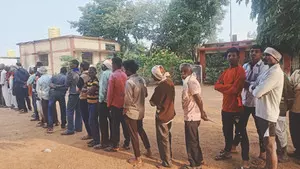Maha records 65.11 per cent polling, highest in three decades

Mumbai, Nov 21 Maharashtra has recorded 65.11 per cent voting during the Assembly election which is for the first time in the last 30 years. The state had recorded 71.69 per cent polling in the 1995 elections when the Shiv Sena-BJP alliance formed the government after the Congress party under the leadership of former chief minister Sharad Pawar refused to take the reins despite emerging as the single largest party by winning 80 seats.
As far as the Election Commission and the office of the Chief Electoral Officer are concerned, they heaved a sigh of relief as their efforts to boost the polling percentage have yielded positive results when compared with 61.39 per cent turnout during the general elections held in May and 61.44 per cent in the 2019 assembly elections.
Compared to the previous elections, the voter turnout has increased by 3.7 per cent. The surge in voting percentage is also attributed to the increase in the number of total voters which was reported at 9.70 crore against 8.94 crore during the 2019 Assembly elections, a rise of 8.50 per cent.
The increase in turnout by first-time voters was also visible across the state. In the case of Mumbai, of the 1.02 crore voters 1,68,422 voters come in the 18-19 years age category and are registered as first-time voters. The extensive awareness campaign carried out by the state election machinery and the non-government organisations helped to lure first-time voters.
Similarly, women voters especially from rural areas and towns queue up for voting. This was attributed to the MahaYuti government’s ambitious Ladki Bahin Yojana. Nearly 2.36 crore eligible women beneficiaries have already received financial aid of Rs 7,500 for five months since July.
In Solapur district, of the total 38.48 lakh voters, 21.97 lakh voters cast their votes with a turnout of 57.09 per cent. However, women’s turnout was higher at 66.23 per cent compared to 62.50 per cent of male voters.
According to the Election Commission’s compilation, Maharashtra had reported 60.36 per cent voters turnout in 1962, 64.84 per cent in 1967, 60.63 per cent in 1972, 67.59 per cent in 1978, 53.2 per cent in 1980, 59.17 per cent in 1985, 62.26 per cent in 1990, 71.69 per cent in 1995, 60.95 per cent in 1999, 63.44 per cent in 204, 59.68 per cent in 2009, 63.38 per cent in 2014 and 61.44 per cent in 2019.
Although the Election Commission has uploaded 65.11 per cent voting percentage as of 11.30 pm on November 20, it is expected to release the final numbers of the voters turnout by 11 pm tonight.
However, some discouragement was seen in urban areas of Mumbai, Mumbai Suburban, Thane, Pune and Nagpur where the turnout was 52.07 per cent, 55.77 per cent, 56.05 per cent, 60.70 per cent and 60.49 per cent respectively against 65.11 per cent at the state level.
The Chief Election Commissioner Rajiv Kumar during his meeting held with the state government in September had expressed a serious concern over the low turnout of less than 50 per cent in 18 assembly constituencies during the Lok Sabha elections observed due to urban apathy. The voting percentage was below 50 per cent in Thane (6), Mumbai City (4), Mumbai Suburbs (2), Pune (5) and Raigad (1).
A senior officer from the state election machinery said: “During the present Assembly elections, a series of measures were adopted to address the urban apathy issue by increasing the number of polling stations in high-rise buildings and cooperative societies complexes and asked the private establishments, in particular, to declare holiday on November 20 to enable the construction and daily wage earners to participate in voting.”
He added that in addition, polling was held on Wednesday and not on weekends or the subsequent day which also helped the voters to cast their votes instead of going on holiday.
He admitted that due to malfunctioning voting machines, slow voting process and queues outside the polling booths, voters in urban areas had expressed strong displeasure that had impacted the voting percentage during the general elections.
“However, the Election Commission's decision to decentralise polling stations in urban areas and allow four voters to enter polling stations at a time prevented a repeat of the chaos in the Lok Sabha elections,” he said.
He further added that by and large, the polling took place peacefully except few complaints of technical snags and incidents of vandalising of polling booths.
Meanwhile, MahaYuti and Maha Vikas Aghadi are making claims that higher polling will pave the way for crossing the magic figure of 145 in the 288-member state Assembly.
Both MahaYuti and Maha Vikas Aghadi are of the view that the increase in voter turnout was also due to the large presence of independents and rebels in the fray apart from voters from different castes and communities thronging to polling stations to cast their votes for candidates from their respective castes and communities.
The caste equation was one of the key factors that was at play during the present election.
Deputy Chief Minister Devendra Fadnavis, who is contesting from Nagpur South West constituency, asserted that an increased voting percentage is beneficial to MahaYuti.
“The voting percentage has increased everywhere in the state, not in Nagpur. Our experience to date is that the BJP has always benefited from this increased percentage. How much we will benefit will come to know after counting that is slated for November 30,” he said.
He said that there are many reasons for the rise in voter turnout, adding that the people have shown affection towards the MahaYuti government.
He clarified that the MahaYuti partners have not held any talks with regard to the post of Chief Minister yet.
On the other hand, the Maharashtra Pradesh Congress Committee President, Nana Patole, who is seeking re-election from the Sakoli constituency, expressed confidence that the Maha Vikas Aghadi will get the majority and form the government in the state.
Further, the Shiv Sena MP Sanjay Raut claimed that the Maha Vikas Aghadi will get 160 to 165 seats to form a stable government in the state.
(Sanjay Jog can be contacted at Sanjay.j@ians.in)
Source: IANS
